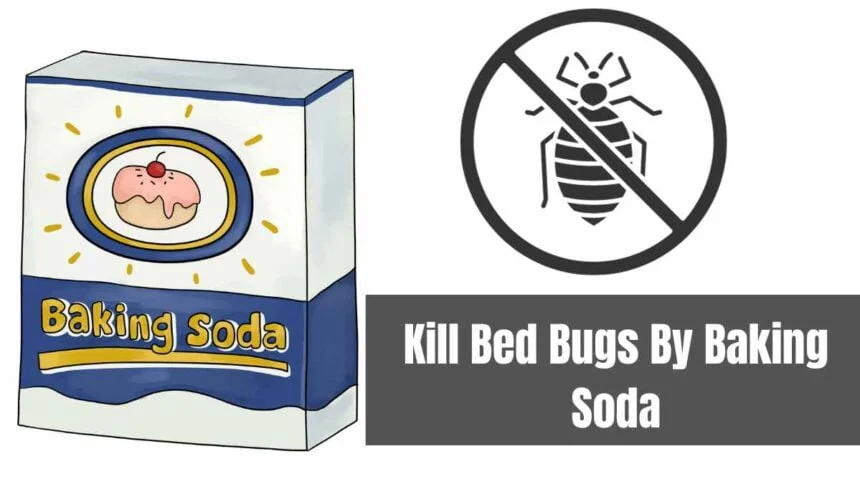Small, flat, oval-shaped insects, bed bugs live exclusively on the blood of humans. Their bites can cause redness, itching, and discomfort, making them a major annoyance. Bed bugs are difficult to eradicate because they may conceal themselves in very small spaces.
Baking soda is one of several home cures explored for eradicating bed bugs. But is it true that baking soda eliminates bed bugs? We should investigate this.
What Are Bed Bugs?
The Cimex lectularius species of bed bugs are parasites that feed only on the blood of their human hosts. They resemble apple seeds in size and are flat, brown, and wingless insects.
Bed bugs spend the daytime in dark crevices and cracks close to bedrooms. They come out at night to feast on the blood of living things, both human and animal.
Without a blood meal, a bed bug can live for up to a year. They have a high temperature tolerance, functioning well between nearly freezing and approximately 113 degrees Fahrenheit.
They are so versatile that they may hide everywhere, from behind baseboards and furniture to in electrical outlets and picture frames.
Over the course of their lives, female bed bugs can produce hundreds of eggs. The eggs are pearly white in color and quite little in size.
They are so faint that they are difficult to spot. Eggs have an adhesive coating that makes them stay put. In around 10 days, they develop into nymphs that feed on blood to mature into adults.
The elusive and well-hidden bed insect. However, humans may experience unpleasant reactions to their bites.
Signs of their existence include the appearance of dark patches on beds and other surfaces, which may be dried blood or excrement. Bed bug elimination involves careful inspection and an IPM strategy.
How Does Baking Soda Work Against Bugs?
Sodium bicarbonate, sometimes known as baking soda, is an all-purpose household cleaner and odor neutralizer.
It has pesticide qualities, therefore it might be able to kill bed bugs if used correctly. Some possible uses of baking soda in the fight against bed bugs are as follows:
- Desiccation: To absorb moisture, baking soda can be used. When sprinkled on insects, it can dehydrate them to death. However, a great deal of personal interaction is required. Bed bugs like to lurk in cracks where they won’t be noticed.
- Abrasiveness: Crystals of baking soda can be rough on the skin. If bed bugs have to crawl through a high amount of wax, their protective covering could be damaged. However, they are able to flee uninjured when exposed to light.
- Alkalinity: Baking soda has a pH of about 8, making it alkaline. A neutral solution is formed when it is diluted with water. On touch, this can disturb the bed bug’s waxy exoskeleton and digestive system. However, it does not catch all of the bugs.
- Odor absorption: The scents caused by bed bugs can be neutralized with baking soda. However, it can help get rid of the stench that comes along with having bed bugs around.
The pesticidal effects of baking soda are weak and only manifest under perfect conditions. It is ineffective because it cannot reach the bed bugs hidden in hard-to-reach places. Baking soda alone will not get rid of serious bed insect infestations, according to scientific data.
How To Use Baking Soda Against Bed Bugs
Incorporating baking soda into an overall strategy for controlling bed bugs can look like this:
- Sprinkle some baking soda into the gaps in the floor and the baseboards near the bed. Pile it low since bed bugs can easily navigate through thin layers. Repeat every two to three days.
- Before encasing mattresses, give them a little dusting with baking soda. Be sure the coating is uniform and fills all the cracks and gaps. Don’t go crazy.
- Make a baking soda moat around your bed, about 1 to 2 inches wide. This may prevent the bed bugs from coming into the bedrooms at night.
- Before caulking, sprinkle baking soda into cracks and crevices. The rough surface is effective for eliminating bed bugs in tight spaces.
- Create a paste by mixing baking soda and water. Use a delicate brush to apply the paste to the tufts, seams, and joints of your furniture. It must be completely dry before being vacuumed.
- Put baking soda between the legs of your furniture to trap any stray cats. It’s possible that some of the bed bugs will accidentally step in the powder while trying to escape.
If you want to get rid of bed bugs for good, you need to apply a combination of techniques, including vacuuming, steam, encasing, traps, and spot-on sprays of insecticide. It’s not a complete fix, but it does help out a lot.
Also See: Does Rubbing Alcohol Kill Bed Bugs?
Does Baking Soda Work For Bed Bugs?
So, does baking soda work against bed bugs? The benefits it offers are summed up as follows:
- The abrasion, oil absorption, and alkalinity of baking soda are the three main mechanisms by which it kills bed bugs. It’s sluggish and requires physical contact to be effective.
- Bed bug infestations that have been around for a while won’t go away with only a light dusting of the cracks and crevices. Baking soda can’t find anything hidden very well.
- Bed bug pheromones and scents can be absorbed, but this does not kill the bugs themselves.
- In an integrated pest management strategy, baking soda is most effective when used in conjunction with steam, vacuuming, sealing cracks, traps, and targeted insecticide application.
- Desiccation, abrasion during movement, and catching stray bugs are some of the ways it can augment existing methods of bed bug control. But it takes time and diligent, repetitive application to see benefits.
- Scientific evidence for baking soda’s ability to eradicate large, established bed bug populations is lacking. Control should not be left entirely up to it.
- Using baking soda in the right way and on a regular basis can help to a small degree in reducing the population of bed bugs. Movement is impeded and some exposed bugs are killed. However, more powerful substances and methods of pest control are required to eradicate an infestation.
- As a non-toxic material, baking soda can be used to enhance other methods of management. However, it does not effectively eliminate bed bugs on its own as advertised.
Conclusion
In certain situations, baking soda’s pesticidal abilities could be enough to kill off the bed bugs you’re trying to get rid of. However, its effectiveness is limited in cases of chronic infestations. If you want to see results, you’ll need to apply it liberally and frequently.
When faced with a large population of bed bugs, baking soda will not be effective. Steam, pesticides, vacuuming, traps, and encasing mattresses are all effective, but should be used in conjunction with it for the best results. Baking soda, when used as an adjunct in the fight against bed bugs, can be helpful.
However, it can never be relied on as a cure-all on its own. The most effective method for eliminating bed bugs forever is called integrated pest management.







